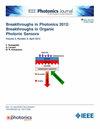基于视线姿态测量的车载量子通信终端指向模型
IF 2.1
4区 工程技术
Q3 ENGINEERING, ELECTRICAL & ELECTRONIC
引用次数: 0
摘要
车载量子通信终端(VQCT)对于建立全球规模的量子网络至关重要。在基于卫星的量子密钥分发(QKD)中,高精度的视线(LOS)指向对于快速可靠地获取信息至关重要。VQCT 的指向精度受到姿态测量误差、机械结构误差以及平台移动导致的结构不稳定性误差的影响。通过在 VQCT 的 LOS 上安装姿态传感器,我们可以直接测量 LOS 的姿态。这就完全消除了机械结构误差和结构不稳定性误差对指向精度的影响。此外,我们还提出了一种指向线校准方法和基于 LOS 姿态测量的 VQCT 指向模型。该模型的指向精度主要取决于姿态传感器的精度。为了验证模型的有效性,我们进行了两项实验。其一是恒星指向实验,与现有的 VQCT 指向模型相比,我们的模型显著降低了 93% 的指向误差,从 1296″ 降至 87.8″。这证明我们的模型消除了机械结构误差和结构不稳定性误差。另一个例子是成功获取了一颗量子通信卫星,这证明了所提出的模型在实现卫星对运动平台 QKD 和全球尺度量子网络方面的可行性。本文章由计算机程序翻译,如有差异,请以英文原文为准。
Pointing Model for Vehicular Quantum Communication Terminals Based on Line-of-Sight Attitude Measurement
Vehicular quantum communication terminals (VQCTs) are crucial for establishing global-scale quantum networks. High-precision line-of-sight (LOS) pointing is essential for fast and reliable acquisition in satellite-based quantum key distribution (QKD). The pointing accuracy of VQCTs is affected by attitude measurement errors, mechanical structure errors, and structural instability errors resulting from platform movement. By mounting attitude sensors on the LOS of VQCTs, we directly measure the LOS attitude. This completely eliminates the impact of mechanical structure errors and structural instability errors on pointing accuracy. Furthermore, we propose a line-of-pointing calibration method and a pointing model for VQCTs based on LOS attitude measurement. The pointing accuracy of this model is primarily reliant on the accuracy of attitude sensors. Two experiments were conducted to validate the effectiveness of our model. One is the star pointing experiment, comparing with the existing pointing model for VQCTs, our model significantly reduces the pointing errors by 93%, from 1296″ to 87.8″. This substantiates that our model eliminates mechanical structure errors and structural instability errors. Another is the successful acquisition of a quantum communication satellite, which demonstrates the feasibility of the proposed model for implementing the satellite-to-motion platform QKD and global-scale quantum networks.
求助全文
通过发布文献求助,成功后即可免费获取论文全文。
去求助
来源期刊

IEEE Photonics Journal
ENGINEERING, ELECTRICAL & ELECTRONIC-OPTICS
CiteScore
4.50
自引率
8.30%
发文量
489
审稿时长
1.4 months
期刊介绍:
Breakthroughs in the generation of light and in its control and utilization have given rise to the field of Photonics, a rapidly expanding area of science and technology with major technological and economic impact. Photonics integrates quantum electronics and optics to accelerate progress in the generation of novel photon sources and in their utilization in emerging applications at the micro and nano scales spanning from the far-infrared/THz to the x-ray region of the electromagnetic spectrum. IEEE Photonics Journal is an online-only journal dedicated to the rapid disclosure of top-quality peer-reviewed research at the forefront of all areas of photonics. Contributions addressing issues ranging from fundamental understanding to emerging technologies and applications are within the scope of the Journal. The Journal includes topics in: Photon sources from far infrared to X-rays, Photonics materials and engineered photonic structures, Integrated optics and optoelectronic, Ultrafast, attosecond, high field and short wavelength photonics, Biophotonics, including DNA photonics, Nanophotonics, Magnetophotonics, Fundamentals of light propagation and interaction; nonlinear effects, Optical data storage, Fiber optics and optical communications devices, systems, and technologies, Micro Opto Electro Mechanical Systems (MOEMS), Microwave photonics, Optical Sensors.
 求助内容:
求助内容: 应助结果提醒方式:
应助结果提醒方式:


